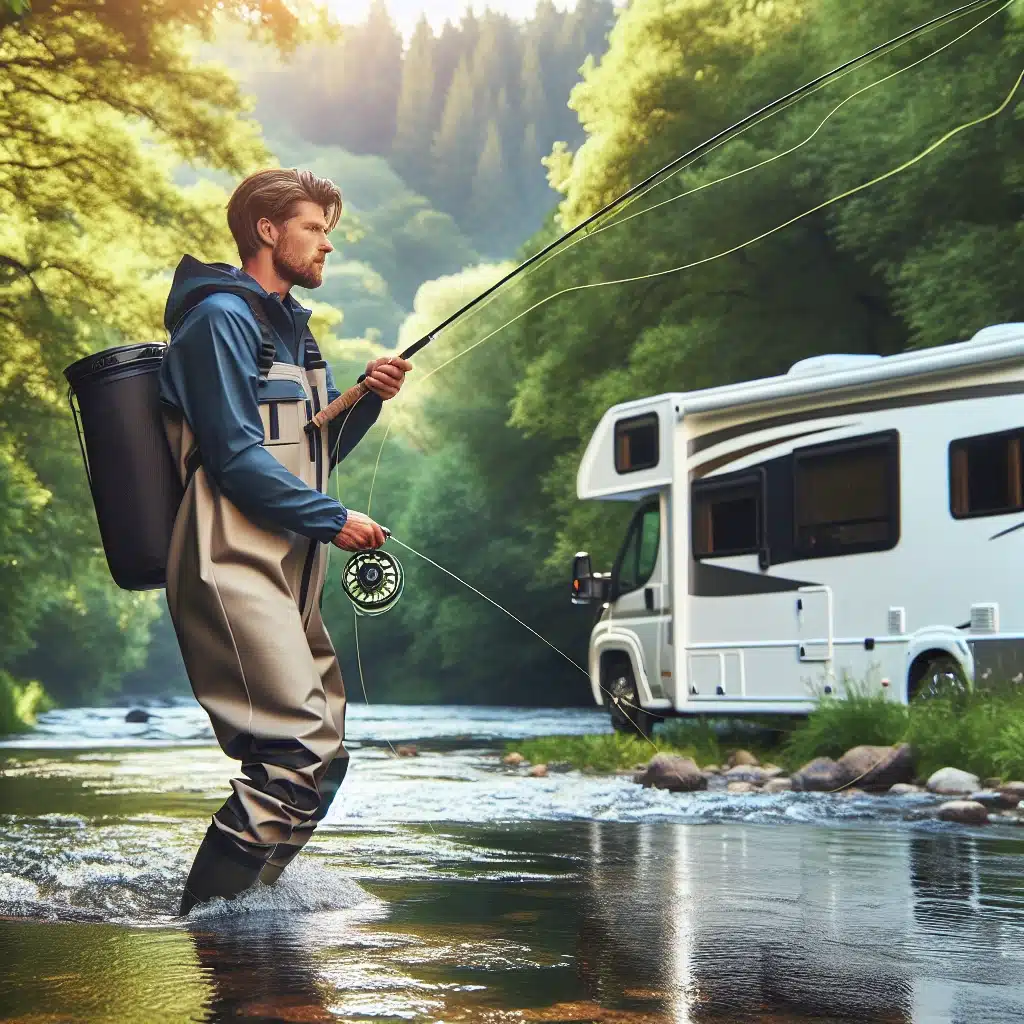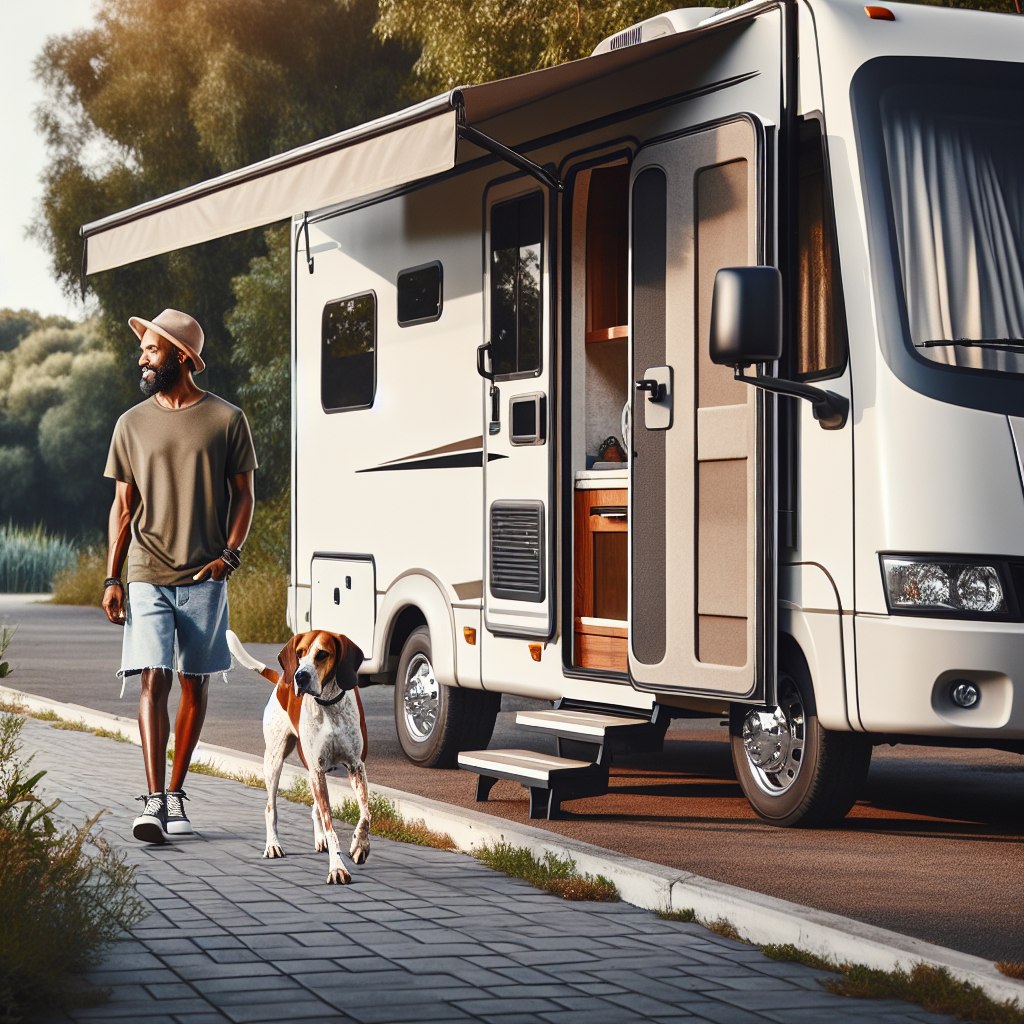Table of Contents

Embrace the Sun: Key Essentials for Your Solar-Powered Boondocking Adventure
Imagine the freedom of exploring off-grid locations without the worry of running out of power. Solar energy is your ticket to that freedom, and setting up your RV with the right solar equipment is easier than you might think. Let’s get your RV ready to harness the power of the sun, so you can enjoy the great outdoors without a generator’s hum or the need to plug in.
Article-at-a-Glance
- Discover the different types of solar panels and which one suits your RV lifestyle.
- Learn how to size your solar panels correctly for your energy needs while boondocking.
- Understand the benefits and drawbacks of fixed versus portable solar panels.
- Find out about the best batteries to store your solar power for reliable off-grid energy.
- Explore the importance of deep cycle batteries and how they fit into your solar setup.
The Core of Sun-Fueled Freedom: Choosing Your Solar Panels
Choosing the right solar panels is like picking the best travel buddy – they need to be reliable, efficient, and ready for adventure. Solar panels come in various shapes and sizes, each with their unique benefits. Your choice will depend on how much power you need and the space available on your RV.
Understanding Solar Panel Types
There are three main types of solar panels: monocrystalline, polycrystalline, and thin-film. Monocrystalline panels are known for their high efficiency and sleek look. Polycrystalline panels are a bit less efficient but generally more affordable. Thin-film panels are lightweight and flexible, perfect for RVs with weight restrictions or curved surfaces.
Sizing Solar Panels to Your Boondocking Needs
How much power do you need? Start by calculating the energy consumption of your appliances and electronics. Then, think about the number of sunlight hours you’ll typically get. A simple formula is to multiply your daily watt-hour requirement by the number of days without sun, then divide by the wattage of the solar panels. This gives you an idea of how many panels you’ll need to keep your batteries charged and your adventures going.
For example:
If you use 1000 watt-hours per day and expect 3 days without sunshine, with 100-watt panels, you’d need at least 10 panels.
Fixed vs. Portable Solar Panels: Pros and Cons
Fixed solar panels are mounted on your RV’s roof, soaking up the sun while you drive or relax at your campsite. They’re great for a ‘set it and forget it’ approach. Portable panels, on the other hand, can be moved to catch the best rays throughout the day, but they require a bit more effort to set up and take down.
- Fixed Solar Panels:
- Convenient and out of the way
- Less risk of theft or damage
- Can be less efficient if the RV is parked in the shade
- Portable Solar Panels:
- Flexibility to position for maximum sun exposure
- Ideal for shaded campsites where you can move panels to the sun
- Requires storage space when not in use

Power Storage Solutions: Batteries That Keep You Going
Once you’ve captured the sun’s energy, you need somewhere to store it. Batteries are the heart of your solar setup, holding onto that power until you need it. The right battery not only stores energy but also ensures it’s delivered smoothly to your appliances, keeping everything running without a hitch.
The Role of Deep Cycle Batteries in Solar Setups
Deep cycle batteries are designed to be discharged and recharged many times, making them perfect for solar setups. They come in various types, including flooded lead-acid, gel, and absorbed glass mat (AGM). These batteries are the workhorses of your solar system, and choosing the right one is crucial for a worry-free boondocking experience.
- Flooded lead-acid batteries are budget-friendly and widely available.
- Gel batteries offer a maintenance-free option with good durability.
- AGM batteries are leak-proof and can handle high power demands.
Lithium vs. AGM Batteries: Making the Right Choice
When it comes to batteries for your solar setup, the two popular choices are Lithium and AGM (Absorbed Glass Mat). Lithium batteries are the newer technology, offering longer lifespans and more usable capacity, which means you can discharge them more without damaging the battery. AGM batteries are more budget-friendly and don’t require a complex management system. They are also very robust and can handle a wide range of temperatures.
- Lithium batteries are lighter and have a higher energy density.
- AGM batteries are typically less expensive upfront.
- Lithium batteries can last more than twice as long as AGM batteries.
- AGM batteries are more forgiving when it comes to charging conditions.
Calculating Battery Capacity for Extended Trips
Knowing how much battery capacity you need is vital for extended boondocking trips. To calculate this, you’ll need to tally up the power usage of all your devices and appliances. Then, consider how many days you want to go between charges. Multiply your daily usage by the number of days to get your total capacity needed. Remember, it’s always better to have a little more capacity than you think you’ll need, to account for variables like weather and unexpected power usage.
For instance, if your daily power usage is 1,000 watt-hours and you plan for a 5-day trip, you’ll need a battery bank that can store at least 5,000 watt-hours.
The Heartbeat of Your Solar System: Charge Controllers
A charge controller is a vital component in your solar power system. It regulates the voltage and current coming from your solar panels to your batteries. Without it, your batteries could overcharge during sunny days or become over-discharged, leading to a shorter lifespan.
MPPT vs. PWM: Selecting Your Charge Controller
There are two main types of charge controllers: MPPT (Maximum Power Point Tracking) and PWM (Pulse Width Modulation). MPPT controllers are more efficient, especially in cooler conditions and when the sun is not at its peak. They adjust the input from the solar panels to deliver the maximum power possible to the batteries. PWM controllers are simpler and more cost-effective but are less efficient than MPPT controllers.
- MPPT controllers can increase charge efficiency by up to 30%.
- PWM controllers work well when the solar panel voltage is similar to the battery voltage.
- MPPT is the choice for larger systems or systems with varying solar conditions.
Optimizing Charge Efficiency for Longevity
To maximize the life of your batteries, it’s important to charge them properly. This means setting up your charge controller to match the specific charging profile of your batteries. Most charge controllers have settings for different battery types, ensuring they get the right amount of power without overcharging. Proper charging not only extends the life of your batteries but also ensures they perform at their best.
Remember to adjust your charge controller settings if you change battery types or add more batteries to your system.

Electrifying Your Energy Supply: Inverters Explained
Inverters are what turn the DC power stored in your batteries into the AC power that most of your appliances use. They are a critical part of your solar setup, especially if you plan to run household items like laptops, kitchen appliances, or entertainment systems.
Pure Sine Wave vs. Modified Sine Wave Inverters
There are two main types of inverters: pure sine wave and modified sine wave. Pure sine wave inverters provide power that’s as good as or better than the power from the grid. This means they’re great for sensitive electronics like laptops or medical equipment. Modified sine wave inverters are less expensive but can cause issues with some devices and aren’t as efficient.
- Pure sine wave inverters are ideal for running sensitive electronics smoothly.
- Modified sine wave inverters work for basic appliances but may cause humming or inefficiency.
Understanding Inverter Power Ratings and Efficiency
When choosing an inverter, you need to consider its power rating, which is measured in watts. Make sure the inverter’s continuous power rating can handle the total wattage of the appliances you want to run simultaneously. Additionally, check the inverter’s peak power rating, which is how much power it can provide for short bursts when appliances like refrigerators start up.
Efficiency is also key. Look for inverters with high efficiency ratings to get the most out of your stored solar power. An efficient inverter will convert most of the battery’s power into usable AC power with minimal loss.
Monitoring and Managing Your Off-Grid Power
Keeping an eye on your solar power system is crucial to ensure everything is running smoothly and efficiently. It’s like checking the vital signs of your RV’s energy health. With the right monitoring tools, you can detect issues early, optimize your energy usage, and extend the life of your solar setup.
Essential Tools and Gauges for Solar System Health
A reliable battery monitor is your best friend when it comes to managing your off-grid power. It gives you real-time insights into how much energy you’re using, how much you’re generating, and the state of your battery’s charge. Think of it as the dashboard of your solar system. Other helpful tools include a solar charge controller with a display and a multimeter for troubleshooting electrical issues.
- Battery monitors display key data like voltage, current, and remaining battery capacity.
- Solar charge controllers with built-in displays provide information on charging status and solar panel output.
- A multimeter is handy for diagnosing electrical problems and ensuring connections are secure.
Best Practices for System Monitoring
To get the most out of your monitoring tools, check them regularly. Make it a part of your daily routine, like enjoying your morning coffee. Keep an eye on your energy consumption patterns and adjust your usage accordingly. If you notice your batteries are discharging faster than usual, it might be time to conserve energy or check for issues.
Always ensure your monitoring tools are properly calibrated for accurate readings. This will help you trust the information you’re seeing and make informed decisions about your energy use.

Solar Accessories: Enhancing Your Boondocking Setup
Accessories can make a good solar setup great. They’re the finishing touches that secure your investment and optimize your energy usage. From mounting kits to efficient lighting, these extras are worth considering to get the most out of your solar-powered boondocking experience.
Mounting Kits and Cables: Securing Your Solar Investment
Mounting kits are essential for attaching your solar panels securely to your RV’s roof. They need to withstand the rigors of the road and the forces of nature. Quality cables are just as important. They must be the right gauge to handle the current from your panels and be properly insulated to withstand the elements.
- Choose mounting kits that are designed for the specific type of solar panels you have.
- Opt for UV-resistant and weatherproof cables to prevent degradation over time.
- Ensure cable lengths are sufficient to reach from your solar panels to your charge controller and batteries without unnecessary splices.
Lighting and Appliances Tailored for Solar Efficiency
LED lighting is a game-changer for solar setups. It consumes a fraction of the power that traditional bulbs use, which means your solar power goes further. When it comes to appliances, look for those designed for energy efficiency. They’ll reduce the strain on your batteries and make your solar investment last longer.
- Replace incandescent bulbs with LED lights to drastically cut down on energy consumption.
- Choose energy-efficient appliances like refrigerators and fans that are rated for solar use.
- Consider adding motion sensors to your lighting to save power when no one is around.
Solar Installation Simplified: Steps for the DIY Enthusiast
Rolling up your sleeves and installing your solar setup can be a rewarding project. It gives you a deeper understanding of your system and can save you money. With the right tools and a bit of know-how, you can get your RV solar-ready in no time.
Gathering Your Tools and Supplies
Before you start, make sure you have all the necessary tools and supplies. You’ll need a drill, screws, sealant, wire strippers, crimping tools, and a wrench set, to name a few. Gather your mounting hardware, cables, connectors, and any safety equipment like gloves and eye protection. Having everything on hand will make the installation process smoother and faster.
- A comprehensive toolset to handle drilling, cutting, and securing components.
- High-quality sealant to waterproof any roof penetrations.
- Durable wire management solutions to keep cables tidy and protected.
Step-by-Step Guide to Installing Your Solar Panels
Installing solar panels might seem daunting, but with a clear plan, it’s a task you can tackle. First, position your mounting brackets to align with the RV’s roof support beams for a secure fit. Next, attach the brackets, ensuring they’re sealed properly to prevent leaks. Then, mount the panels onto the brackets, connect the wiring, and run the cables to your charge controller and batteries. Finally, secure all cables with clips to prevent damage while on the move.
- Locate your RV’s roof support beams for secure bracket placement.
- Seal and attach the mounting brackets to the roof.
- Mount the solar panels onto the brackets and secure them.
- Connect the wiring from the panels to your charge controller.
- Run the cables to your batteries, using clips to secure them along the way.
Troubleshooting Common Installation Hurdles
Even with the best plans, you might hit a snag. If your solar panels aren’t charging the batteries as expected, check all connections for tightness and corrosion. Ensure the charge controller is set to the correct battery type and that the system isn’t shaded. If you encounter a leak, reapply sealant and check for any gaps around the mounts. Remember, most issues come down to connections and settings, so start there.
- Check connections for tightness and signs of corrosion.
- Verify the charge controller settings match your battery type.
- Inspect for shading that might affect panel efficiency.
- Reapply sealant if you find water leaks around the mounts.

Maintaining Your Solar Setup for Optimal Performance
Regular maintenance is key to getting the most out of your solar setup. It’s not just about keeping the panels clean; it’s also about ensuring all components of your system are working together harmoniously. A well-maintained system will serve you reliably for years to come.
Cleaning and Caring for Solar Panels
Keeping your solar panels clean is essential for peak performance. Dust, leaves, and bird droppings can reduce their efficiency. Clean your panels with a soft cloth or sponge and a mild detergent. Avoid abrasive materials or harsh chemicals that can damage the surface. Regular cleaning, especially after a trip or during pollen season, will keep your panels absorbing as much sunlight as possible.
- Use a soft cloth or sponge to gently wipe the panels.
- Avoid abrasive materials that could scratch the panel surface.
- Perform cleaning in the morning or evening to avoid hot surfaces.
Regular System Checks and Balancing
Periodic checks of your entire solar system are crucial. Ensure your batteries are holding a charge and that connections remain tight and free of corrosion. Balance your system by checking the charge controller’s readouts and adjusting settings as needed. Keep an eye on your energy consumption and compare it to the expected output to make sure your system is balanced and efficient.
- Test battery charge levels regularly.
- Inspect all electrical connections for tightness and corrosion.
- Adjust charge controller settings for optimal charging.
- Monitor energy consumption versus output to ensure system efficiency.
Weathering the Elements: Solar Resilience in Harsh Conditions
Your solar setup needs to be tough enough to withstand whatever Mother Nature throws at it. From scorching sun to freezing snow, preparing your system for extreme conditions will ensure it keeps running smoothly.
Protecting Your System from Extreme Weather
Secure your solar panels and mounts to withstand high winds. Use UV-resistant cables and sealants to protect against sun damage. In areas prone to snow, consider tilt mounts to help shed snow and allow for easier cleaning. Always have a plan for quick disconnection in case of severe storms that might require you to move or protect your panels.
- Ensure all mounts and panels are securely attached to resist wind.
- Use UV-resistant materials to prevent weathering.
- Install tilt mounts for easier snow removal and cleaning.
- Have a quick-disconnect system for emergency panel removal.
Ensuring Continuous Power During Overcast Days
Even on cloudy days, your solar panels can still gather energy, albeit at a reduced rate. To ensure you have enough power, consider increasing your battery storage capacity or adding more panels to compensate for the lower efficiency. Use energy more sparingly on these days, and plan for activities that require less power. A well-designed system with a bit of foresight can keep you powered through those less-than-sunny days.
- Expand battery storage to maintain power during low-light conditions.
- Add additional panels to increase energy collection on overcast days.
- Conserve energy by reducing usage and planning low-power activities.
FAQs: Solar Power for Boondocking Explained
How Often Do I Need to Replace My Solar Panels and Batteries?
Solar panels are built to last. Most come with a warranty of 25 years, and they can keep working beyond that, although their efficiency might decrease over time. Batteries, on the other hand, have shorter lifespans. Depending on the type and how well you maintain them, deep cycle batteries can last between 2 to 7 years. Lithium batteries have a longer lifespan, often lasting up to 10 years or more with proper care.
What Is The Ideal Number of Solar Panels for Full-Time Boondocking?
The ‘ideal’ number varies based on your energy needs. A good rule of thumb is to calculate your daily power usage and have enough solar capacity to recharge your battery bank from 50% to full in one sunny day. For full-time boondocking, you might want a system that can generate around 30 kWh per month per 100 watts of solar panels. So, if your usage is around 300 kWh per month, you’d need about 1,000 watts of solar panels.
How Do I Calculate My Energy Consumption While Boondocking?
Start by listing all your electronic devices and appliances. Note their wattage and how many hours you use them each day. Multiply the wattage by the hours used to get the daily watt-hours for each item. Add up these amounts to find your total daily consumption. For example, if a light uses 10 watts and is on for 5 hours a day, that’s 50 watt-hours per day for just that light.
Can I Run Air Conditioning on Solar Power When Boondocking?
Yes, but air conditioning units consume a lot of power. You’ll need a substantial solar panel setup and a large battery bank. For instance, a typical RV air conditioner might use around 1,500 watts. To run it for just 2 hours a day would require 3,000 watt-hours, not including your other power needs. You’ll need to calculate your total energy needs, including the air conditioner, to determine the size of your solar and battery system.
In conclusion, harnessing the sun’s power for your boondocking adventures is not just environmentally friendly, it’s also a liberating way to explore the world in your RV. With the right solar setup, you can enjoy the comforts of home while being miles away from the nearest plug-in.
Remember to consider your energy needs, choose the right components, and maintain your system for optimal performance. Solar power for boondocking is an investment in freedom and sustainability, so take the leap and let the sun power your next journey!
- Boondocking RVs: Flexible Solar Solutions – 3 March 2024
- Renewable Energy Tips for Full-Time Boondocking RVers – 2 March 2024
- Boondocking Solar Power Systems: Sizing Options & Solutions for Motorhomes – 1 March 2024
